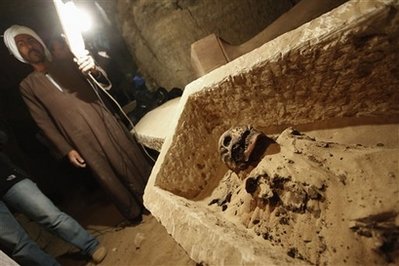10 – Who cracked off the Sphinx’s nose?
- You would think it might’ve been during a World War, or when Napoleon reached Egypt
- But all of these events took place 60 years after the first known drawings of the Sphinx without a nose in the 1730s
- At this point there are no documented leads, though an Islamic cleric Sa’im al-dahr DID vandalise the Sphinx in the 1370s but he was punished for it
- The nose thief remains anonymous to this day
9 – All of Ancient Egypt hasn’t been discovered yet
- Most would believe that Egyptology was dead – how could we be in 2014 and still making new discoveries?
- Easy, everything’s buried over hundreds of miles of sand – the Egyptians ruled for thousands of years so naturally there’d still be quite a bit
- In fact, as recently as the start of this year we discovered a new Pharaoh Woseribre Senebkay from 3,600 years ago
- It was buried near the tomb of King Sobekhotep from the 13th Dynasty, and it came with a whole slew of coloured illustrations
8 – Egyptian women were equal to men
- And in every way this was true – unlike in Greece where women were basically owned by their husbands, Egyptian women were legally and financially independent, they had the right to divorce and remarry and negotiate ancient prenuptial agreements
- While women were typically assigned to home duties, they still received the same payments as men and were entitled to compensation in the event of divorce
- It was a society of tolerance, respect and equal rights without question
7 – Their fashion protected against head-lice
- For the more well-off Egyptians, they wore full wigs; the middle or lower class would wear long hair often in pig tails
- But for children aged 12 and under, their heads were shaved except for one plaited lock
- Not only was this a sort of “coming of age” fashion statement, but it was to prevent fleas and lice attacking children’s heads – and like the anti-biotic bread, it worked quite well
6 – Were Egyptians obsessed with death?
- The firm answer is no; however, it’s easy to jump to the conclusion they were due to building pyramid tombs, mummifying bodies and preserving them
- In reality though, they saw death as simply another chapter in life – where they could continue working for their Pharaoh without being held back by their biological forms
- We’ve seen old pottery from families of the deceased, demanding they get back to work as if they hadn’t died at all, they were just being lazy in the afterlife
- And they built the pyramids to allow their beloved Pharaohs and, by proxy, the Egyptian people to live on in the glorious afterlife
- They didn’t see death as you and I see death







I saw the same exhibit when it was in Chicago a few years ago, and I had the exact same reaticon. I would have loved the exhibit if I had had an honest idea of what to expect. But they used images of the big gold pieces to advertise it, and I left feeling pretty bitterly disappointed. November 9, 2012
“In Greece women were basically owned by their husbands” That was a fact till the 5th century. After the end of the battles, Greek women were political and social activ in the society.
Although, in ancient Egypt till 2800, the woman was killed and buried with her husband, so she could keep serving him in the afterlife. That stoped for financial reasons only.
Oh yea, they were black